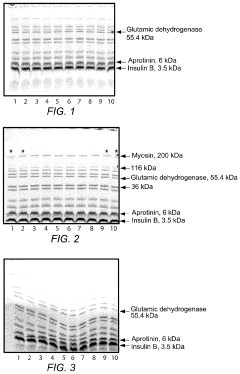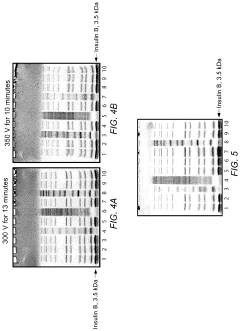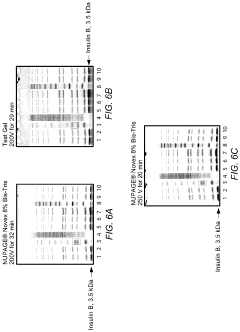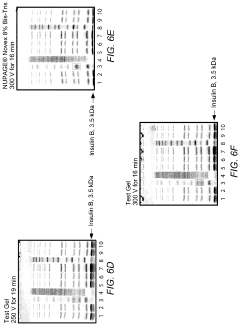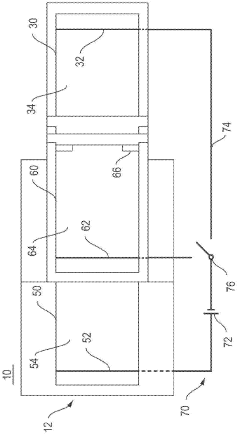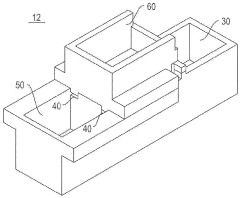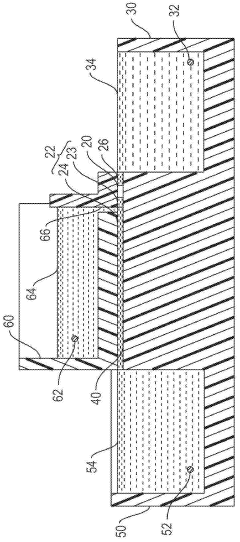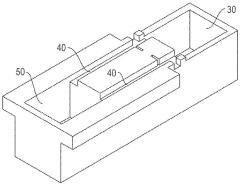How to Maximize Separation Efficiency in Gel Electrophoresis?
JUN 30, 20259 MIN READ
Generate Your Research Report Instantly with AI Agent
Patsnap Eureka helps you evaluate technical feasibility & market potential.
Gel Electrophoresis Evolution and Objectives
Gel electrophoresis has evolved significantly since its inception in the 1930s, becoming a cornerstone technique in molecular biology and biochemistry. Initially developed for protein separation, the method has undergone numerous refinements to enhance its capabilities and applications. The evolution of gel electrophoresis has been driven by the increasing demand for more precise and efficient separation of biomolecules, particularly nucleic acids.
In the 1950s and 1960s, the introduction of polyacrylamide gels and the development of sodium dodecyl sulfate-polyacrylamide gel electrophoresis (SDS-PAGE) marked significant milestones. These advancements allowed for better resolution and molecular weight determination of proteins. The 1970s saw the adaptation of gel electrophoresis for DNA separation, revolutionizing genomic research and forensic science.
The advent of pulsed-field gel electrophoresis (PFGE) in the 1980s expanded the technique's capabilities, enabling the separation of much larger DNA fragments. This innovation was crucial for genome mapping and the analysis of chromosomal DNA from various organisms. Concurrently, the development of capillary electrophoresis offered increased automation and higher throughput.
Recent years have witnessed further refinements, including the introduction of microfluidic devices for electrophoresis, which allow for miniaturization and integration with other analytical techniques. Additionally, advancements in gel matrix materials and buffer systems have continued to improve separation efficiency and resolution.
The primary objective in maximizing separation efficiency in gel electrophoresis is to achieve optimal resolution of biomolecules while minimizing run time and sample consumption. This involves optimizing various parameters such as gel composition, pore size, electric field strength, and buffer conditions. Researchers aim to enhance the technique's sensitivity, allowing for the detection and separation of increasingly smaller quantities of biomolecules.
Another key objective is to expand the range of molecules that can be effectively separated, including challenging samples such as membrane proteins or very large DNA fragments. Improving the reproducibility and standardization of gel electrophoresis protocols is also crucial, especially for applications in clinical diagnostics and quality control.
Furthermore, there is a growing focus on developing more environmentally friendly and safer alternatives to traditional gel electrophoresis methods, which often rely on toxic compounds. This includes exploring bio-based gel materials and less hazardous staining techniques.
As the field of molecular biology continues to advance, gel electrophoresis techniques are expected to evolve further, with a particular emphasis on integration with high-throughput sequencing technologies and proteomics platforms. The ultimate goal is to create more powerful, versatile, and user-friendly electrophoresis systems that can meet the diverse needs of modern biological and biomedical research.
In the 1950s and 1960s, the introduction of polyacrylamide gels and the development of sodium dodecyl sulfate-polyacrylamide gel electrophoresis (SDS-PAGE) marked significant milestones. These advancements allowed for better resolution and molecular weight determination of proteins. The 1970s saw the adaptation of gel electrophoresis for DNA separation, revolutionizing genomic research and forensic science.
The advent of pulsed-field gel electrophoresis (PFGE) in the 1980s expanded the technique's capabilities, enabling the separation of much larger DNA fragments. This innovation was crucial for genome mapping and the analysis of chromosomal DNA from various organisms. Concurrently, the development of capillary electrophoresis offered increased automation and higher throughput.
Recent years have witnessed further refinements, including the introduction of microfluidic devices for electrophoresis, which allow for miniaturization and integration with other analytical techniques. Additionally, advancements in gel matrix materials and buffer systems have continued to improve separation efficiency and resolution.
The primary objective in maximizing separation efficiency in gel electrophoresis is to achieve optimal resolution of biomolecules while minimizing run time and sample consumption. This involves optimizing various parameters such as gel composition, pore size, electric field strength, and buffer conditions. Researchers aim to enhance the technique's sensitivity, allowing for the detection and separation of increasingly smaller quantities of biomolecules.
Another key objective is to expand the range of molecules that can be effectively separated, including challenging samples such as membrane proteins or very large DNA fragments. Improving the reproducibility and standardization of gel electrophoresis protocols is also crucial, especially for applications in clinical diagnostics and quality control.
Furthermore, there is a growing focus on developing more environmentally friendly and safer alternatives to traditional gel electrophoresis methods, which often rely on toxic compounds. This includes exploring bio-based gel materials and less hazardous staining techniques.
As the field of molecular biology continues to advance, gel electrophoresis techniques are expected to evolve further, with a particular emphasis on integration with high-throughput sequencing technologies and proteomics platforms. The ultimate goal is to create more powerful, versatile, and user-friendly electrophoresis systems that can meet the diverse needs of modern biological and biomedical research.
Market Analysis for Advanced Separation Techniques
The market for advanced separation techniques, including gel electrophoresis, has been experiencing steady growth due to increasing demand in various sectors such as biotechnology, pharmaceuticals, and academic research. Gel electrophoresis, a fundamental technique in molecular biology, plays a crucial role in separating and analyzing DNA, RNA, and proteins. The global market for electrophoresis equipment and supplies is projected to reach significant value in the coming years, driven by advancements in proteomics and genomics research.
The demand for improved separation efficiency in gel electrophoresis is primarily fueled by the need for more accurate and sensitive analysis of complex biological samples. Researchers and industry professionals are constantly seeking ways to enhance resolution, reduce analysis time, and increase throughput. This has led to a growing market for innovative electrophoresis systems, high-performance gels, and advanced imaging technologies.
In the pharmaceutical and biotechnology sectors, the adoption of advanced separation techniques is crucial for drug discovery, quality control, and production processes. The increasing focus on personalized medicine and biomarker discovery has further boosted the demand for high-resolution separation methods. Academic and research institutions also contribute significantly to market growth, as they require cutting-edge tools for various genomics and proteomics studies.
Geographically, North America and Europe dominate the market for advanced separation techniques, owing to their well-established research infrastructure and substantial investments in life sciences. However, the Asia-Pacific region is emerging as a rapidly growing market, driven by increasing research activities, rising healthcare expenditure, and government initiatives to promote biotechnology and pharmaceutical industries.
The market landscape is characterized by intense competition among key players, who are continuously investing in research and development to introduce innovative products. Major companies are focusing on developing integrated systems that offer improved separation efficiency, automation, and user-friendly interfaces. Additionally, there is a growing trend towards miniaturization and portability of electrophoresis systems, catering to the needs of point-of-care diagnostics and field research applications.
As the demand for more efficient and precise separation techniques continues to rise, the market is expected to witness the introduction of novel technologies and materials. This includes the development of advanced gel matrices, optimized buffer systems, and sophisticated software for data analysis. The integration of artificial intelligence and machine learning algorithms in electrophoresis systems is also anticipated to drive market growth by enhancing data interpretation and workflow automation.
The demand for improved separation efficiency in gel electrophoresis is primarily fueled by the need for more accurate and sensitive analysis of complex biological samples. Researchers and industry professionals are constantly seeking ways to enhance resolution, reduce analysis time, and increase throughput. This has led to a growing market for innovative electrophoresis systems, high-performance gels, and advanced imaging technologies.
In the pharmaceutical and biotechnology sectors, the adoption of advanced separation techniques is crucial for drug discovery, quality control, and production processes. The increasing focus on personalized medicine and biomarker discovery has further boosted the demand for high-resolution separation methods. Academic and research institutions also contribute significantly to market growth, as they require cutting-edge tools for various genomics and proteomics studies.
Geographically, North America and Europe dominate the market for advanced separation techniques, owing to their well-established research infrastructure and substantial investments in life sciences. However, the Asia-Pacific region is emerging as a rapidly growing market, driven by increasing research activities, rising healthcare expenditure, and government initiatives to promote biotechnology and pharmaceutical industries.
The market landscape is characterized by intense competition among key players, who are continuously investing in research and development to introduce innovative products. Major companies are focusing on developing integrated systems that offer improved separation efficiency, automation, and user-friendly interfaces. Additionally, there is a growing trend towards miniaturization and portability of electrophoresis systems, catering to the needs of point-of-care diagnostics and field research applications.
As the demand for more efficient and precise separation techniques continues to rise, the market is expected to witness the introduction of novel technologies and materials. This includes the development of advanced gel matrices, optimized buffer systems, and sophisticated software for data analysis. The integration of artificial intelligence and machine learning algorithms in electrophoresis systems is also anticipated to drive market growth by enhancing data interpretation and workflow automation.
Current Challenges in Gel Electrophoresis Efficiency
Gel electrophoresis remains a cornerstone technique in molecular biology, yet it faces several challenges in maximizing separation efficiency. One of the primary issues is the limitation in resolving power, particularly for DNA fragments of similar sizes. As the demand for higher resolution in genomic and proteomic studies increases, this constraint becomes more pronounced, especially when dealing with complex mixtures of biomolecules.
Another significant challenge is the time-consuming nature of the process. Traditional gel electrophoresis can take hours to achieve adequate separation, which is a bottleneck in high-throughput applications. This prolonged duration not only reduces laboratory productivity but also increases the risk of sample degradation and band diffusion, potentially compromising the accuracy of results.
The heterogeneity of gel matrices poses another hurdle. Inconsistencies in pore size and distribution can lead to irregular migration patterns, affecting the reproducibility of results across different experiments or laboratories. This variability is particularly problematic when precise quantification or comparison of samples is required.
Joule heating during electrophoresis presents a persistent challenge. As electric current passes through the gel, it generates heat, which can cause band distortion, increased diffusion, and in extreme cases, gel melting. This thermal effect is especially problematic when working with longer gels or applying higher voltages to accelerate separation.
Sample overloading is another common issue that compromises separation efficiency. Excessive sample volumes or concentrations can lead to band broadening and poor resolution. Determining the optimal loading capacity for different gel types and sample compositions remains a challenge, often requiring extensive optimization.
The limited dynamic range of detection methods associated with gel electrophoresis also presents difficulties. Traditional staining techniques may not accurately represent the true abundance of molecules, especially at the lower and upper extremes of concentration. This limitation can lead to misinterpretation of results, particularly in quantitative analyses.
Lastly, the manual nature of many gel electrophoresis procedures introduces variability and potential for human error. From gel preparation to sample loading and interpretation of results, each step is susceptible to inconsistencies that can affect the overall separation efficiency and reliability of the technique.
Addressing these challenges requires a multifaceted approach, combining improvements in gel composition, electrophoresis hardware, and detection methods. Innovations such as pulsed-field gel electrophoresis and capillary electrophoresis have emerged to tackle some of these issues, but there remains significant room for advancement in maximizing the separation efficiency of gel electrophoresis.
Another significant challenge is the time-consuming nature of the process. Traditional gel electrophoresis can take hours to achieve adequate separation, which is a bottleneck in high-throughput applications. This prolonged duration not only reduces laboratory productivity but also increases the risk of sample degradation and band diffusion, potentially compromising the accuracy of results.
The heterogeneity of gel matrices poses another hurdle. Inconsistencies in pore size and distribution can lead to irregular migration patterns, affecting the reproducibility of results across different experiments or laboratories. This variability is particularly problematic when precise quantification or comparison of samples is required.
Joule heating during electrophoresis presents a persistent challenge. As electric current passes through the gel, it generates heat, which can cause band distortion, increased diffusion, and in extreme cases, gel melting. This thermal effect is especially problematic when working with longer gels or applying higher voltages to accelerate separation.
Sample overloading is another common issue that compromises separation efficiency. Excessive sample volumes or concentrations can lead to band broadening and poor resolution. Determining the optimal loading capacity for different gel types and sample compositions remains a challenge, often requiring extensive optimization.
The limited dynamic range of detection methods associated with gel electrophoresis also presents difficulties. Traditional staining techniques may not accurately represent the true abundance of molecules, especially at the lower and upper extremes of concentration. This limitation can lead to misinterpretation of results, particularly in quantitative analyses.
Lastly, the manual nature of many gel electrophoresis procedures introduces variability and potential for human error. From gel preparation to sample loading and interpretation of results, each step is susceptible to inconsistencies that can affect the overall separation efficiency and reliability of the technique.
Addressing these challenges requires a multifaceted approach, combining improvements in gel composition, electrophoresis hardware, and detection methods. Innovations such as pulsed-field gel electrophoresis and capillary electrophoresis have emerged to tackle some of these issues, but there remains significant room for advancement in maximizing the separation efficiency of gel electrophoresis.
Existing Strategies for Enhancing Separation Efficiency
01 Gel composition optimization
Improving separation efficiency in gel electrophoresis by optimizing the gel composition. This includes adjusting the concentration and type of gel-forming polymers, crosslinking agents, and buffer systems to enhance resolution and separation of biomolecules.- Optimization of gel composition: Improving separation efficiency in gel electrophoresis can be achieved by optimizing the gel composition. This includes adjusting the concentration and type of polymer used, as well as incorporating additives that enhance resolution. Tailoring the gel composition to the specific molecules being separated can significantly improve the overall separation efficiency.
- Electric field manipulation: Manipulating the electric field during gel electrophoresis can enhance separation efficiency. This includes techniques such as pulsed-field gel electrophoresis, gradient gel electrophoresis, and the use of alternating current. These methods can improve the resolution of molecules with similar sizes or charges.
- Sample preparation and loading techniques: Improving sample preparation and loading techniques can significantly enhance separation efficiency. This includes methods for concentrating samples, removing interfering substances, and ensuring uniform sample application. Proper sample preparation can lead to sharper bands and improved resolution.
- Buffer system optimization: Optimizing the buffer system used in gel electrophoresis can improve separation efficiency. This includes adjusting buffer composition, pH, and ionic strength to enhance the resolution of specific molecules. Tailoring the buffer system to the sample and gel composition can lead to better separation results.
- Novel detection and visualization methods: Implementing novel detection and visualization methods can enhance the apparent separation efficiency of gel electrophoresis. This includes using fluorescent dyes, chemiluminescent markers, and advanced imaging techniques to improve the sensitivity and resolution of band detection. These methods can reveal subtle differences in separation that may not be visible with traditional staining techniques.
02 Electric field manipulation
Enhancing separation efficiency through manipulation of the electric field applied during gel electrophoresis. This involves techniques such as pulsed-field gel electrophoresis, alternating current, or gradient electric fields to improve the resolution of DNA fragments or proteins.Expand Specific Solutions03 Sample preparation and loading techniques
Improving separation efficiency by optimizing sample preparation and loading methods. This includes techniques for concentrating samples, removing interfering substances, and developing novel sample application methods to enhance resolution and reduce band broadening.Expand Specific Solutions04 Microfluidic and miniaturized systems
Enhancing separation efficiency through the development of microfluidic and miniaturized gel electrophoresis systems. These systems offer advantages such as faster separation times, reduced sample volumes, and improved heat dissipation, leading to better resolution and efficiency.Expand Specific Solutions05 Detection and imaging improvements
Increasing separation efficiency by enhancing detection and imaging techniques. This includes the development of high-sensitivity fluorescence detection methods, real-time monitoring systems, and advanced image analysis algorithms to improve the accuracy and resolution of gel electrophoresis results.Expand Specific Solutions
Key Players in Electrophoresis Industry
The gel electrophoresis market is in a mature growth stage, with a global market size estimated to exceed $1.5 billion. The technology is well-established and widely used in research and clinical applications. Key players like Life Technologies, Beckman Coulter, and Sage Science are driving innovation through advanced systems that offer improved separation efficiency and automation. Emerging trends include microfluidic-based electrophoresis and integration with next-generation sequencing workflows. While the core technology is mature, ongoing developments in sample preparation, detection methods, and data analysis continue to enhance performance and expand applications across genomics, proteomics, and diagnostics.
Life Technologies Corp.
Technical Solution: Life Technologies Corp. has developed advanced gel electrophoresis systems that maximize separation efficiency. Their E-Gel™ system utilizes pre-cast agarose gels with integrated electrodes, allowing for rapid and high-resolution DNA separation[1]. The company has also introduced the E-Gel™ Power Snap Electrophoresis Device, which combines electrophoresis and imaging in one instrument, reducing hands-on time and improving reproducibility[2]. Additionally, Life Technologies offers optimized buffers and reagents that enhance DNA migration and band sharpness, contributing to improved separation efficiency[3].
Strengths: Integrated systems for faster and more consistent results, high-resolution separation capabilities. Weaknesses: Proprietary consumables may increase ongoing costs, limited flexibility for customization.
Beckman Coulter, Inc.
Technical Solution: Beckman Coulter has developed innovative solutions to maximize separation efficiency in gel electrophoresis. Their ProteomeLab PA 800 system utilizes capillary electrophoresis technology, which offers higher resolution and faster separation times compared to traditional slab gel electrophoresis[4]. The company has also introduced the GenomeLab GeXP Genetic Analysis System, which combines capillary electrophoresis with multiplexed PCR for high-throughput genetic analysis[5]. Beckman Coulter's approach focuses on miniaturization and automation to improve separation efficiency and reproducibility while reducing sample and reagent consumption[6].
Strengths: High-resolution separations, reduced sample requirements, automation capabilities. Weaknesses: Higher initial investment, may require specialized training for operation.
Innovative Approaches in Gel Matrix Design
System for rapid high-resolution GEL electrophoresis
PatentActiveUS20190391113A1
Innovation
- The development of electrophoretic systems and formulations that allow for higher field strengths up to 50% more than conventional systems, using a discontinuous buffer system with specific gel amine and ampholyte buffers, and a pH range of 5.5 to 7.5, enabling faster separation of proteins within 30 minutes or less, even at higher voltages.
Gel electrophoresis apparatus and gel electrophoresis method
PatentWO2015133190A1
Innovation
- A gel electrophoresis apparatus and method that includes a well for whole blood, with a power supply system to switch voltage application between electrodes, allowing electrophoresis to resume by switching from the first and second electrodes to the second and third electrodes, preventing blood cells from accumulating in the electrophoretic gel and maintaining the energizing function of the second and third electrodes.
Environmental Impact of Electrophoresis Materials
Gel electrophoresis, while a powerful analytical technique, has environmental implications that warrant careful consideration. The materials used in this process, particularly the gels and buffers, can have significant environmental impacts if not properly managed. Agarose and polyacrylamide, the two most common gel materials, are not readily biodegradable and can persist in the environment for extended periods. When disposed of improperly, these materials can contribute to soil and water pollution, potentially affecting ecosystems and wildlife.
The buffers used in electrophoresis, such as Tris-borate-EDTA (TBE) and Tris-acetate-EDTA (TAE), contain chemicals that can be harmful to aquatic life if released into water systems. EDTA, in particular, is a chelating agent that can mobilize heavy metals in the environment, potentially increasing their bioavailability and toxicity. Furthermore, the use of ethidium bromide as a DNA staining agent poses significant environmental and health risks due to its mutagenic properties.
The production of electrophoresis materials also has environmental implications. The manufacturing processes for agarose and polyacrylamide gels require energy and resources, contributing to carbon emissions and resource depletion. Additionally, the packaging materials used for these products, often single-use plastics, add to the growing problem of plastic waste in the environment.
To mitigate these environmental impacts, researchers and laboratories are exploring more sustainable alternatives. Bio-based gels, such as those derived from seaweed or other plant sources, are being developed as biodegradable alternatives to traditional synthetic gels. These materials offer the potential for reduced environmental persistence and easier disposal. Similarly, efforts are being made to develop less toxic DNA staining agents to replace ethidium bromide, such as SYBR Green or GelRed, which are less mutagenic and pose fewer environmental risks.
Waste management practices in laboratories are also evolving to address the environmental concerns associated with electrophoresis materials. Proper segregation and disposal of gel waste, including recycling of buffer solutions where possible, can significantly reduce the environmental footprint of these techniques. Some institutions are implementing on-site treatment systems to neutralize or decontaminate electrophoresis waste before disposal, further minimizing potential environmental impacts.
As the scientific community becomes increasingly aware of the environmental implications of laboratory practices, there is a growing trend towards the development of "green" electrophoresis techniques. These approaches aim to maximize separation efficiency while minimizing environmental impact through the use of sustainable materials, energy-efficient equipment, and improved waste management protocols. By addressing the environmental concerns associated with electrophoresis materials, researchers can continue to benefit from this valuable analytical technique while reducing its ecological footprint.
The buffers used in electrophoresis, such as Tris-borate-EDTA (TBE) and Tris-acetate-EDTA (TAE), contain chemicals that can be harmful to aquatic life if released into water systems. EDTA, in particular, is a chelating agent that can mobilize heavy metals in the environment, potentially increasing their bioavailability and toxicity. Furthermore, the use of ethidium bromide as a DNA staining agent poses significant environmental and health risks due to its mutagenic properties.
The production of electrophoresis materials also has environmental implications. The manufacturing processes for agarose and polyacrylamide gels require energy and resources, contributing to carbon emissions and resource depletion. Additionally, the packaging materials used for these products, often single-use plastics, add to the growing problem of plastic waste in the environment.
To mitigate these environmental impacts, researchers and laboratories are exploring more sustainable alternatives. Bio-based gels, such as those derived from seaweed or other plant sources, are being developed as biodegradable alternatives to traditional synthetic gels. These materials offer the potential for reduced environmental persistence and easier disposal. Similarly, efforts are being made to develop less toxic DNA staining agents to replace ethidium bromide, such as SYBR Green or GelRed, which are less mutagenic and pose fewer environmental risks.
Waste management practices in laboratories are also evolving to address the environmental concerns associated with electrophoresis materials. Proper segregation and disposal of gel waste, including recycling of buffer solutions where possible, can significantly reduce the environmental footprint of these techniques. Some institutions are implementing on-site treatment systems to neutralize or decontaminate electrophoresis waste before disposal, further minimizing potential environmental impacts.
As the scientific community becomes increasingly aware of the environmental implications of laboratory practices, there is a growing trend towards the development of "green" electrophoresis techniques. These approaches aim to maximize separation efficiency while minimizing environmental impact through the use of sustainable materials, energy-efficient equipment, and improved waste management protocols. By addressing the environmental concerns associated with electrophoresis materials, researchers can continue to benefit from this valuable analytical technique while reducing its ecological footprint.
Automation and Integration in Electrophoresis Systems
Automation and integration in electrophoresis systems have revolutionized the field of gel electrophoresis, significantly enhancing separation efficiency and overall productivity. These advancements have transformed traditional manual processes into streamlined, high-throughput operations, capable of handling complex sample sets with unprecedented speed and accuracy.
Modern automated electrophoresis systems incorporate robotic sample handling, precise temperature control, and integrated imaging capabilities. These features minimize human error, ensure reproducibility, and allow for continuous operation without constant supervision. Automated gel loading systems, for instance, can precisely dispense samples into wells, eliminating variations in sample volume and reducing cross-contamination risks.
Integration of electrophoresis systems with other analytical techniques has further expanded their capabilities. Coupling gel electrophoresis with mass spectrometry or next-generation sequencing platforms enables comprehensive analysis of complex biological samples. This integration facilitates rapid identification and characterization of separated molecules, providing researchers with a more complete understanding of their samples.
Advanced software solutions play a crucial role in automation and integration efforts. These programs control instrument parameters, monitor separation progress, and analyze results in real-time. Machine learning algorithms are increasingly being employed to optimize separation conditions based on sample characteristics and desired outcomes, further maximizing efficiency.
Microfluidic technologies have emerged as a promising avenue for miniaturization and integration of electrophoresis systems. Lab-on-a-chip devices incorporate multiple analytical steps, including sample preparation, separation, and detection, into a single, compact platform. These integrated systems not only reduce sample and reagent consumption but also dramatically decrease analysis time.
The trend towards automation and integration in electrophoresis systems has significant implications for various fields, including clinical diagnostics, forensics, and pharmaceutical research. High-throughput screening applications benefit from the ability to process large numbers of samples quickly and consistently. In clinical settings, automated systems enable rapid and accurate analysis of patient samples, potentially leading to faster diagnoses and treatment decisions.
As automation and integration continue to advance, we can expect further improvements in separation efficiency, resolution, and throughput. The development of smart, self-optimizing systems that can adapt to varying sample types and separation requirements represents an exciting frontier in electrophoresis technology. These innovations will undoubtedly contribute to pushing the boundaries of what is possible in molecular separation and analysis.
Modern automated electrophoresis systems incorporate robotic sample handling, precise temperature control, and integrated imaging capabilities. These features minimize human error, ensure reproducibility, and allow for continuous operation without constant supervision. Automated gel loading systems, for instance, can precisely dispense samples into wells, eliminating variations in sample volume and reducing cross-contamination risks.
Integration of electrophoresis systems with other analytical techniques has further expanded their capabilities. Coupling gel electrophoresis with mass spectrometry or next-generation sequencing platforms enables comprehensive analysis of complex biological samples. This integration facilitates rapid identification and characterization of separated molecules, providing researchers with a more complete understanding of their samples.
Advanced software solutions play a crucial role in automation and integration efforts. These programs control instrument parameters, monitor separation progress, and analyze results in real-time. Machine learning algorithms are increasingly being employed to optimize separation conditions based on sample characteristics and desired outcomes, further maximizing efficiency.
Microfluidic technologies have emerged as a promising avenue for miniaturization and integration of electrophoresis systems. Lab-on-a-chip devices incorporate multiple analytical steps, including sample preparation, separation, and detection, into a single, compact platform. These integrated systems not only reduce sample and reagent consumption but also dramatically decrease analysis time.
The trend towards automation and integration in electrophoresis systems has significant implications for various fields, including clinical diagnostics, forensics, and pharmaceutical research. High-throughput screening applications benefit from the ability to process large numbers of samples quickly and consistently. In clinical settings, automated systems enable rapid and accurate analysis of patient samples, potentially leading to faster diagnoses and treatment decisions.
As automation and integration continue to advance, we can expect further improvements in separation efficiency, resolution, and throughput. The development of smart, self-optimizing systems that can adapt to varying sample types and separation requirements represents an exciting frontier in electrophoresis technology. These innovations will undoubtedly contribute to pushing the boundaries of what is possible in molecular separation and analysis.
Unlock deeper insights with Patsnap Eureka Quick Research — get a full tech report to explore trends and direct your research. Try now!
Generate Your Research Report Instantly with AI Agent
Supercharge your innovation with Patsnap Eureka AI Agent Platform!
